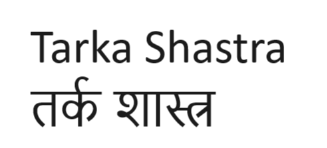Here are some key concepts you can learn from Tarka Shastra, the Indian philosophy of logic and reasoning:
- Categories of knowledge (padarthas): Tarka Shastra identifies fundamental categories that make up the universe. Understanding these categories is essential for clear thinking and analysis.
- Valid reasoning: Tarka Shastra teaches methods for constructing sound arguments and identifying fallacies. This is helpful in evaluating information and forming your own well-reasoned beliefs.
- Debate and argumentation: Tarka Shastra emphasizes the art of debate, with defined roles for presenting opposing viewpoints (purva paksha and apara paksha). This can help you develop your critical thinking skills and effectively argue your own position.
- Sources of knowledge: Tarka Shastra explores how we gain knowledge, examining the role of perception, inference, and testimony. This can help you understand the limitations and strengths of different ways of knowing.
- Logical fallacies: Tarka Shastra identifies common errors in reasoning, allowing you to avoid them in your own thinking and identify them in the arguments of others.
By studying Tarka Shastra, you can develop a sharper mind, become a more critical thinker, and improve your ability to communicate and reason effectively.
Tarka Shastra places a strong emphasis on debate as a tool for refining knowledge and reaching truth. Here’s how it explains the process of debate:
- Purva Paksha and Apara Paksha: This is a key concept in Tarka Shastra debate. It refers to the two opposing viewpoints presented:
- Purva Paksha: This is the initial position or thesis presented for discussion.
- Apara Paksha: This is the counter-argument or opposing viewpoint that challenges the purva paksha.
- Structured Discourse: The debate is expected to follow a specific structure. Both parties present their arguments logically, using evidence and reasoning to support their positions. They may also raise counter-arguments (siddhantas) to expose flaws in the opposing view.
- Emphasis on Logic and Reasoning: Unlike modern debates that can get heated or emotional, Tarka Shastra emphasizes logic and sound reasoning over persuasion or personal attacks. The goal is to arrive at the truth through a rigorous examination of arguments.
- Fairness and Objectivity: Tarka Shastra promotes fairness and objectivity in the debate process. Both sides are expected to present their cases without bias and be open to revising their views based on stronger arguments.
Here are some additional points to consider:
- Role of the Debater: The debaters in Tarka Shastra are not simply advocating for their own beliefs; they are seen as investigators seeking truth.
- Avoiding Fallacies: As mentioned earlier, Tarka Shastra identifies fallacies in reasoning (Hetu Dosha) to ensure the debate remains focused on sound logic.
- Reaching a Conclusion: The ideal outcome of a Tarka Shastra debate is not necessarily to win or defeat an opponent, but to arrive at a well-reasoned conclusion that advances understanding.
In essence, Tarka Shastra views debate as a collaborative exercise in critical thinking, where participants work together to refine ideas and uncover truth through logical argumentation.
While being a foundational text for Indian logic and reasoning, doesn’t directly belong to a specific philosophical school within Hinduism. The theory of knowledge sources (Pramana) is most comprehensively developed in the Nyaya Sutra, the foundational text of the Nyaya school.
However, Tarka Shastra heavily borrows from Nyaya’s Pramana theory. Here are the four main sources of knowledge according to this perspective:
- Pratyaksha (Perception): This refers to direct knowledge gained through our senses. It’s considered the most fundamental source of knowledge, but its validity can be limited by factors like faulty sense organs or illusions.
- Anumana (Inference): This involves using reason and logic to arrive at a conclusion based on observed evidence. For example, seeing smoke and inferring fire.
- Upamana (Comparison): This involves gaining knowledge by comparing something unfamiliar to something familiar. For instance, understanding a new fruit by comparing it to a known one.
- Shabda (Verbal Testimony): This refers to knowledge gained through the words of reliable sources, like experts or scriptures. However, Tarka Shastra emphasizes the importance of evaluating the credibility of the source before accepting their testimony.
It’s important to note that some schools of Hinduism, like Vedanta, propose additional sources of knowledge beyond these four.
Tarka Shastra doesn’t use the exact term “logical fallacies” but focuses on identifying faulty reasoning through different categories. Here are some ways Tarka Shastra addresses faulty arguments:
- Hetu Dosha (Fallacious Probans): This refers to flaws in the reason (hetu) used to support a conclusion. Tarka Shastra identifies several types of Hetu Dosha, including:
- Savyabhichara (Inconclusive): Evidence that doesn’t definitively support the conclusion.
- Viruddha (Contradictory): Evidence that contradicts itself or established knowledge.
- Prakaranasama (Neutralized): Evidence that creates doubt or neutrality on the issue.
- Asiddha Sadhana (Affirming the Consequent): This fallacy assumes that because something follows from a proposition, the proposition itself must be true.
- Anaikantika (Inconclusive Middle Term): This fallacy occurs when the middle term in a syllogism (the term that connects the major and minor premises) is ambiguous or has multiple meanings.
While Tarka Shastra doesn’t have direct equivalents to modern logical fallacies like straw man or ad hominem, these categories capture similar ideas of faulty reasoning.
Here are some resources for further exploration:
- “[Fallacious Reasoning According to Tarka Shaastra by Suryanarayana Jammalamadaka]”([YouTube video])

